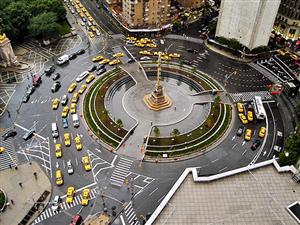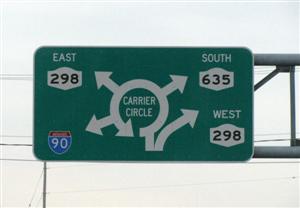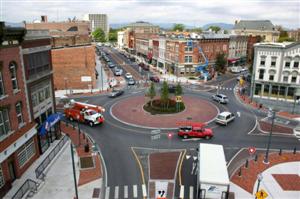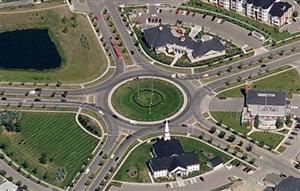February 2009 TRUCKER TALK
ROUND & ROUND WE GO
BY WRITER & OWNER OPERATOR KIM GRIMM
With roundabouts and traffic circles popping up around the country like dandelions in the spring, I thought I would do a little research and write about them. Sometimes called rotaries, I remember these strange intersections from years ago in the northeast, along with “jug handles” where left turns are made from the right lane. If designed properly, they can actually be pretty efficient. But I really believe that the people designing the roundabouts today are forgetting that here in the United States we have trucks and trailers that are over 70 feet long.
A traffic circle is an intersection with a circular shape and, usually, a central island. In some traffic circles, two-way traffic is allowed within the circle, but it is much more common that traffic is allowed to go in only one direction around the circle. Originally, traffic entering a circle had the right-of-way, but in today’s modern roundabouts, the traffic entering the circle must yield to traffic already in the circulatory roadway. Rotaries are typically larger than roundabouts, which enable high-speed merging, but because they usually gave priority to the entering traffic, they were prone to traffic congestion because too many vehicles could enter the circle at once.
 Contrary to popular belief, modern roundabouts are safer than traditional intersections with traffic signals or stop signs because they have fewer points of conflict and they reduce the speed of vehicles within the intersection. A 2001 study reviewed 24 intersections around the U.S. that had been converted from traditional intersections to modern roundabouts. The study found that all crashes were reduced by 39% and that serious crashes were reduced by 76%. At the time of the study, there had been no fatalities at any of the new roundabouts. The study estimated that fatal or incapacitating injuries would be reduced by 90% at those intersections, and said that the crashes that do occur tend to be minor because of the reduced traffic speeds.
Contrary to popular belief, modern roundabouts are safer than traditional intersections with traffic signals or stop signs because they have fewer points of conflict and they reduce the speed of vehicles within the intersection. A 2001 study reviewed 24 intersections around the U.S. that had been converted from traditional intersections to modern roundabouts. The study found that all crashes were reduced by 39% and that serious crashes were reduced by 76%. At the time of the study, there had been no fatalities at any of the new roundabouts. The study estimated that fatal or incapacitating injuries would be reduced by 90% at those intersections, and said that the crashes that do occur tend to be minor because of the reduced traffic speeds.
The first traffic circle in the U.S. was opened in New York City in 1905. The Columbus Circle (which was named after Christopher Columbus) was designed by William P. Eno. This circle is located at the intersection of Broadway, Central Park West, Central Park South (59th Street) and Eighth Avenue. The monument at the center, created by Italian sculptor Gaetano Russo, is the point at which distances to and from New York City are officially measured. The monument in the center of the circle consists of a marble statue of Columbus atop a 70-foot granite column decorated with bronze reliefs representing each of Columbus’ ships: the Niña, the Pinta and the Santa Maria. Its pedestal features an angel holding a globe.
In the early days of roundabouts and circles there were no consistent right-of-way rules. In 1913, Wisconsin was the first state to adopt the yield-to-right rule, meaning entering vehicles had the right-of-way. The drawback to this rule was the fact that traffic could (and often would) lock up in the circle. From the early 1920s onward, in conjunction with a rapidly developing auto industry and technology, the design philosophy of traffic circles evolved to allow higher speeds through the intersection and create larger circles (rotaries) to keep things moving. But, as traffic volumes continued to increase, more and more traffic circles locked up (some traffic jams were so bad, they required police intervention to free up the standstill).
 Although the rotary became very popular in the 1930s, construction of these types of intersections pretty much ended on December 7, 1941. During WWII, President Eisenhower’s attention was caught by the German autobahns. When highway crews resumed construction after the war, the effort shifted to the German-style freeways, which became our current interstate system. The closest thing we have to a rotary or a roundabout on the interstate today is the on and off ramps that circle around and cross over each other at the entry and exit points. These are usually dangerous ramps for drivers because a lot of accidents occur there – especially truck rollovers.
Although the rotary became very popular in the 1930s, construction of these types of intersections pretty much ended on December 7, 1941. During WWII, President Eisenhower’s attention was caught by the German autobahns. When highway crews resumed construction after the war, the effort shifted to the German-style freeways, which became our current interstate system. The closest thing we have to a rotary or a roundabout on the interstate today is the on and off ramps that circle around and cross over each other at the entry and exit points. These are usually dangerous ramps for drivers because a lot of accidents occur there – especially truck rollovers.
We have Great Britain to thank for the modern roundabout. As more of their circles became congested, British officials installed signs at the entrances asking drivers to give way to the vehicles in the roundabout. Tests and research found that the “priority-to-the-circle” rule (also known as “off-side” priority) increased capacity by 10%, reduced delays by 40% and decreased injury accidents by 40%. The off-side priority rule was officially adopted for roundabouts in Great Britain in 1966, which required the entering traffic to yield to the already circulating vehicles. And thus, the “modern roundabout” was created. From then on, roundabout design changed from the larger circles with emphasis on merging and weaving, to the smaller roundabouts where the driver’s job was to accept a gap in the circulating flow. But it was too late for the U.S.
In the 1950s, traffic circles fell out of favor in the United States because of the locking problem and high accident rates. In many cases, they were replaced with signalized intersections, or signals were simply added to the circle. By 1995, the New Jersey DOT had destroyed 37 of their 67 historic rotaries and replaced them with traffic lights. Not until recently has the roundabout begun to regain some acceptance in the U.S. (mostly because of their success in several countries in Europe and in Australia). These newly designed modern roundabouts are usually criticized at first, but later, as the local drivers get used to them, they are accepted (and even praised). In addition to slowing vehicles down, roundabouts virtually end the danger of t-bone accidents that are so common (and deadly) at traditional intersections caused by cars and trucks running red lights. And, as an added bonus, these traffic circles are usually an attractive focal point to any community.
 With the merging and weaving theory now abandoned and the “gap theory” adopted, modern roundabouts are making a big comeback. This would be great if only cars traveled in these circles, but when they are put in places where trucks have to use them too, that should be considered in the design. A beautiful center island is nice to look at, but it can be difficult to get around with a truck if it is surrounded by a high curb and the circle is tight – especially if you are pulling a drop-deck trailer or a car hauler. In fact, it can be downright impossible!
With the merging and weaving theory now abandoned and the “gap theory” adopted, modern roundabouts are making a big comeback. This would be great if only cars traveled in these circles, but when they are put in places where trucks have to use them too, that should be considered in the design. A beautiful center island is nice to look at, but it can be difficult to get around with a truck if it is surrounded by a high curb and the circle is tight – especially if you are pulling a drop-deck trailer or a car hauler. In fact, it can be downright impossible!
Recently in Syracuse, New York, I went around a huge roundabout that was very car and truck friendly. Since one of the entrances into this circle was off I-90, it had actually been designed for trucks. Another roundabout designed with trucks in mind is in St. George, Utah at exit 4 off of I-15. Since that is the exit for the Flying J Truck Stop located nearby, it carries a lot of truck traffic and has been designed accordingly – the lanes are wide enough and the curbs are low so it is easy to get around the nicely landscaped center island.
In contrast to the pleasant roundabout in Utah, the one in De Pere, Wisconsin (near Green Bay) is ridiculous. A “mini roundabout” (which is really designed for small, quiet streets or in residential neighborhoods) was placed at the end of a street where there are several truck-related shops including Cummins, Thermo King, Peterbilt, Pomp’s Tire Service, a truck repair facility and a truck lettering business. Did they not think that trucks would have to use this mini roundabout? The brick is pretty, but, again, the curb in the center can be too high for a lower trailer to get around. What were these dumb people thinking? I guess they weren’t!
I once went to an old warehouse that had five docks, but they could only accommodate two trucks and trailers. And once they were in, you had to wait for the other one to leave. The other three docks could only accommodate 6-wheel trucks. When I asked the receiver about it, he told me that the engineer who designed the building didn’t realize how big trucks would become. I think it’s the same way with the streets. Automobile drivers love to complain about trucks and the amount of road they use, but there wouldn’t be a problem if they just designed the roads to safely accommodate the needs of a tractor-trailer.
After traveling some 2.5 million miles, I’d like to think that I’m a pretty good driver, but the roundabout off the South Towne exit in Madison, Wisconsin (which takes you around to Wal-Mart) messes me up every time! I always get in the wrong lane. I was really grateful that I was bobtailing one day through this roundabout, on my way to get new front springs on my truck, because I don’t think that I could have made it with my trailer in tow. I feel bad for all of the truck drivers that have to use this roundabout to deliver to the local businesses in the area (such as the Wal-Mart). Again, there are several truck-related shops off this exit. And then, pile up a little snow in this circle where there is already just enough room to get around, and it gets even more fun to negotiate.
I don’t see the roundabouts going away, so I guess that we’d better just get used to them. I do hope that the engineers and city planners will consider the trucks traveling through these circles and design them accordingly. They seem to be good in regards to safety, but they are just one more obstacle for us truckers to deal with. So be safe out there as you drive round and round – I guess that’s pretty much what we do most of the time anyway, only our circles are bigger (they stretch from one end of the country to the other). Round and round we go!
